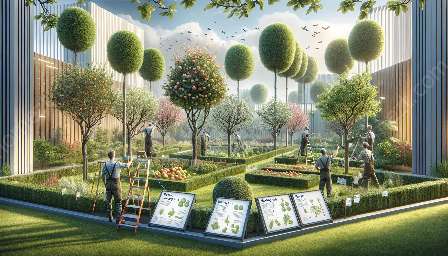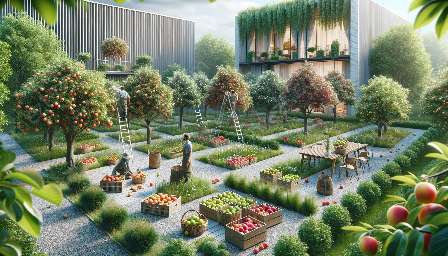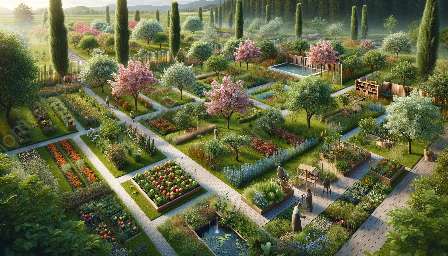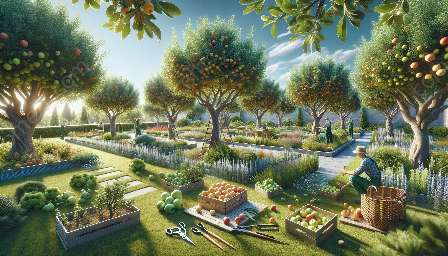Healthy and well-maintained fruit trees play a crucial role in both gardens and orchards, providing a bountiful harvest and adding natural beauty to the surroundings. This comprehensive guide will delve into various training and shaping techniques for trees, specifically focusing on orchard management and garden applications.
Understanding Tree Training and Shaping
Tree training and shaping involve manipulating the growth pattern of a tree to encourage desirable traits such as improved fruit production, easier harvest, and overall tree health. These techniques are particularly important in orchards and gardens, where maximizing yield and promoting a strong, sustainable tree structure are key goals.
Pruning and Training Methods
One of the most fundamental techniques in tree and orchard management is pruning, which involves selectively removing certain branches to promote better growth or achieve a desired shape. In addition to traditional pruning, other training methods such as espalier, fan training, and pollarding can be used to control tree growth and optimize fruit production.
Pruning
Pruning is the process of removing specific branches to promote healthy growth and shape the tree. This technique is crucial for maintaining an open canopy structure, allowing for better light penetration and air circulation, which in turn reduces the risk of disease and improves fruit quality.
Espalier
Espalier training involves training a tree to grow flat against a support, such as a wall or a trellis, by systematically pruning and tying branches. This method is ideal for limited spaces, as it allows for easy access and effective use of available area while creating a visually appealing display.
Fan Training
Fan training, commonly used for stone fruit trees, entails arranging the branches in a fan-shaped pattern against a support. This technique maximizes sunlight exposure and facilitates efficient harvesting, making it a popular choice in both orchards and gardens.
Pollarding
Pollarding is a severe form of pruning that involves cutting back the main branches to promote the growth of new, vigorous shoots. While not commonly used in orchards, this technique is employed to control the size and shape of trees in specific garden settings.
Implementing Shaping Techniques in Orchard Management
Effective orchard management requires a deep understanding of tree shaping techniques and their application in commercial fruit production. Training and shaping trees in the orchard involve a combination of pruning, espalier, and other methods to ensure optimal fruit yield and tree health.
Structural Pruning
Structural pruning is vital for young orchard trees to establish a strong framework that can support the weight of future fruit crops. By removing unwanted or competing branches, structural pruning shapes the tree's canopy and encourages the development of sturdy, well-spaced branches.
Renewal Pruning
Renewal pruning is a technique used to rejuvenate older fruit trees by removing older branches and stimulating the growth of new, productive wood. This method contributes to the overall vitality and productivity of the orchard, especially for long-lived fruit tree varieties.
Shaping for High-Density Orchards
In high-density orchards, where space is limited and efficient fruit production is paramount, specialized shaping techniques such as spindle and palmette systems are commonly employed. These systems involve specific pruning and training methods to maximize tree density and optimize fruit quality and yield.
Applying Training and Shaping Techniques in Garden Settings
For home gardeners and landscaping enthusiasts, incorporating tree training and shaping techniques can elevate the beauty and functionality of fruit trees. Whether in a small backyard garden or a larger landscape, these methods can enhance the visual appeal of the space while promoting fruit production.
Garden Fruit Tree Pruning
Pruning is essential for maintaining fruit trees in garden settings, as it controls growth, improves airflow, and enhances fruit quality. Gardeners can employ various pruning techniques, including rejuvenation, formative, and maintenance pruning, based on the tree's age and growth pattern.
Decorative Shaping
Besides standard pruning practices, gardeners often use decorative shaping techniques, such as topiary and bonsai, to create visually striking and unique tree forms. These artistic approaches add an ornamental element to the garden while showcasing the natural beauty of fruit trees.
Integrating Trees with Garden Design
When incorporating fruit trees into garden designs, considerations such as placement, spacing, and shaping play a crucial role. By integrating trees harmoniously with other garden elements, such as pathways, flower beds, and seating areas, gardeners can create a cohesive and inviting outdoor space.





















